Super League Gaming Leans Into Digital Gameplay, Remote Production as Audience Grows During Lockdown
The amateur-esports organization deploys unique remote-production workflow
Story Highlights
Launched in 2014, Super League Gaming originally aimed to bring amateur esports into the spotlight by hosting competitive esports events at venues ranging from movie theaters and malls to Top Golf and Dave & Buster’s locations. However, with physical locations shut down due to the coronavirus pandemic, Super League quickly pivoted to online events and creating original content — an effort that has been rewarded with significant audience growth.
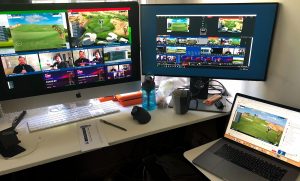
Super League Gaming’s production crew are located remotely at their homes with its new remote workflow.
“Before the pandemic hit, we had a very active business with gameplay experiences at almost 500 physical venues,” says Super League Chief Commercial Officer Matt Edelman. “That was going extremely well, but we always understood the foundation of our growth was going to be digital. We knew we were going to develop our community long-term by enabling gameplay through digitally connected experiences that are more seamless and scalable than relying solely upon visits to physical venues.
“Digital was always a core component,” he continues, “and the digital foundation that we had already put in place has ended up yielding new opportunities [during the pandemic lockdown].”
As Esports Audience Spikes, Super League Ramps Up Content Output
With gamers stuck at home and sports fans left without live events during the pandemic, esports viewership across Twitch, YouTube, Facebook, and other outlets has skyrocketed over the past three months as major esports tournaments have continued via online gameplay. In addition, consumption of gameplay highlights on social-media platforms like Instagram, TikTok, and Snapchat has grown exponentially.
Super League has converted several of its physical events to digital experiences and has seen registration numbers accelerate dramatically. In addition, its MineHut community — a Minecraft serving/hosting platform that allows players to create custom environments and invite others to join — has more than tripled since the lockdown began. And, perhaps most notably, Super League has seen significant viewership increases for its user-generated gameplay-highlights channels across Instagram, TikTok, and Snapchat.
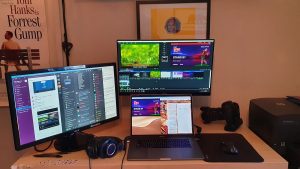
Super League Gaming’s remote-production workflow heavily leverages AWS EC2, NDI and NewTek tools, vMix switching, and Singular.Live graphics.
“The viewership of our highlights channels has accelerated beyond what we ever expected,” says Edelman. “The [MineHut and gameplay-highlights] communities’ rapid growth gave us confidence to lean in even more aggressively around digitally based gameplay experiences and original content.”
With more eyeballs looking for esports content than ever before, Super League has developed a remote-production model that leverages a combination of AWS EC2 cloud infrastructure and resources at its existing production facility in Santa Monica, CA, to churn out original content and live events at a breakneck pace.
“In parallel with our significant digital growth was our fast move to a fully remote content-production and -streaming [model] based on some unique and proprietary technology combined customized workflows integrating multiple systems generally not otherwise designed to work together,” says Edelman. “As a result, we have been able to scale our content production in a manner that has not been as easy for many companies during this period.”
Inside Super League Gaming’s Remote-Production Workflow
Remote production is nothing new to Brian Gramo, director, live production and SuperLeagueTV. When he started at Super League in 2018, his Bakersfield-to-Santa Monica commute forced him to stay in his RV in the studio’s parking lot during the week. To remedy that situation, he and his team gradually developed a production model that would allow the Super League team to access the Santa Monica “local control” remotely.
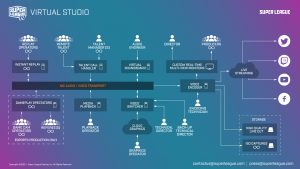 “We’ve now been doing various forms of remote production for about two years,” says Gramo. “But, when the [lockdown] hit, we ramped it up very quickly. The timeline was fairly rapid: immediately, we started using the existing remote infrastructure that we already had in place, and, within 30 days, we were fully remote.”
“We’ve now been doing various forms of remote production for about two years,” says Gramo. “But, when the [lockdown] hit, we ramped it up very quickly. The timeline was fairly rapid: immediately, we started using the existing remote infrastructure that we already had in place, and, within 30 days, we were fully remote.”
These days, SuperLeagueTV (SLGTV) is operating a virtual production-control room accessible to multiple producers, technical directors, sound engineers, and other staff. Live streams are recorded simultaneously through a cloud-based infrastructure and made available for distribution to multiple broadcast endpoints in real time, whether for viewing on Twitch, YouTube, and Facebook or for viewing by production staff and talent producing a show to be aired on a future date.
Super League’s local studio, which is based on New Tek’s NDI IP format, features the vendor’s TriCaster TC1 production system, Connect Pro IP video-translation system, and Spark video converters. Shut out of the studio in March, the SuperLeagueTV production team immediately began using a variety of remote-desktop applications (notably, Windows and Chrome) and VPN tools to access resources in the control room.
In addition to remoting into the studio, SuperLeagueTV developed a fully cloud-based workflow in AWS EC2, leveraging the vMix software-based switcher and Singular.Live graphics for live productions. Much of SuperLeague’s I/O — including multiviews — are handled with NDI over WAN, providing plenty of flexibility when both the AWS EC2 environment and its Santa Monica control room are used.
“We are heavily leveraging NDI over WAN, so we can have sources coming back and forth over NDI with nearly zero latency,” says Gramo. “If we need additional [resources] or additional recording or we need to access a particular machine at local control, we can take that into our EC2 cloud workflow with NDI over WAN and utilize our existing infrastructure without actually having to spin up another EC2 cloud box.”
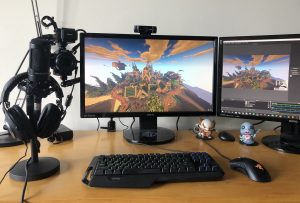
Super League Gaming had already been developing a remote-production solution but has ramped up its efforts significantly since the lockdown began.
All operators use the NICE DCV remote-desktop interface included for free as part of the AWS EC2 platform. In addition, SLGTV is less reliant on ultra-high-speed or redundant end-user internet connections since it adds redundancy in the cloud workflow.
Today, SuperLeagueTV is primarily using the AWS EC2 environment and augmenting its shows with resources from the local control room.
“One of our most recent productions [on May 23] was fully remote and didn’t utilize any brick-and-mortar infrastructure whatsoever,” says Gramo. “We had five EC2 instances spun up with different operators controlling each in different combinations, and not one physical piece of hardware was used at all. It’s exciting that we have that option now.”
Red Zone for Esports: How Super League Produces Whip-Around Coverage
SLGTV’s live-event coverage differs from high-profile esports leagues like League of Legends Championship Series (LCS), Overwatch League, and Call of Duty League: most of its broadcasts feature dozens of games happening simultaneously, with hundreds of competitors rather than a single match at the core of the broadcast. Bracket-style tournaments like City Champs (which has different iterations for LoL, Clash Royale, and Minecraft, and other games) require the production team to create whip-around coverage that spotlights compelling moments in each match.
“With the way Super League works,” says Gramo, “there is a lot happening at once, so we essentially have to create an NFL Red Zone type of experience for a game like League of Legends. With something like [LCS] or Overwatch League, there is only a single event with one game happening at a time. But, with something like City Champs, we have to have 64 concurrent games streaming.”
When an in-game spectator is not available, Super League’s proprietary “camera character” technology creates a spectator view during a multiplayer game. Essentially, a virtual character is placed in a game with “real” players for the purpose of visualizing the action from the perspective of that character. Its movements are triggered by a form of artificial intelligence designed to follow the most interesting and exciting action of each game.
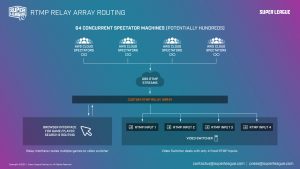 To pull this off, Gramo’s team created a custom web portal to route its proprietary RTMP relay array to manage the various spectators. SLGTV also uses high-powered GPU instances (g3.8xlarge and g3.16xlarge) to generate its spectator AV right in the cloud environment. This guarantees multiple synced observer feeds with high-end render-quality settings.
To pull this off, Gramo’s team created a custom web portal to route its proprietary RTMP relay array to manage the various spectators. SLGTV also uses high-powered GPU instances (g3.8xlarge and g3.16xlarge) to generate its spectator AV right in the cloud environment. This guarantees multiple synced observer feeds with high-end render-quality settings.
“We can spin up spectators in AWS,” says Gramo, “and then we have a custom web interface to allow us to search for the best [content] when concurrent matches are going on. We can search by user and get an overview of what games are happening, and then we can pull those up in preview boxes right in the web browser. So we have a preview from the AWS spectators almost like [the multiviewer] in the control room. And our custom interface lets us route all those RTMP relays to create the show.”
While the spectator view is nothing new to SLGTV, Gramo adds that the move to the cloud has allowed his team to add more to each show, along with more virtual-operator positions.
“We were limited to two spectators previously, but, for our next Minecraft event, we’re going to have 10 spectators,” he says. “Now, instead of being limited by the number of hardware stations we have [onsite], we can have an infinite amount of spectators or infinite amount of replay operators or anything else. The AWS EC2 cloud solution enables us to do that. I think, even when we’re back in the studio, you’re going to see a lot of elements remain in the cloud.”
Looking to the Future: Maintaining Momentum Post-Lockdown
Although events at physical venues are sure to resume at some point, Edelman believes that the advances Super League has made during the lockdown will help transform its business. With the cloud-based remote-production ecosystem in place, he also sees Super League’s business growing beyond just esports and expanding to other unscripted programming like reality shows, talk shows, and game shows.
“Outside of gaming, our system is remarkably well-designed and suited to serve any kind of unscripted program,” he says. “It’s ideal for any show that needs to deliver real-time interaction between multiple participants on-camera in a remote setting.”
As for its esports plans, Edelman says, the company plans to launch a new experiential gameplay platform on SuperLeague.com this month that is going to “have features and components that we believe are unlike any of the other digital gameplay platforms out there today.
“We’re applying all the learnings we took from gameplay in physical venues and applying that to the digital gameplay experience on SuperLeague.com,” he continues. “We see a big opportunity ahead of us right now with the growth of our digital-player base and our social community. We’re highly confident that growth will follow even after the stay-at-home orders cease. We’ve definitely hit new plateaus, and we’ll be growing from those plateaus. We think our core Super League-branded offerings are going to be pretty remarkable moving forward.”
